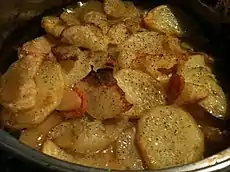Lancashire hotpot
Lancashire hotpot is a stew originating in Lancashire in the North West of England. It consists of lamb or mutton and onion, topped with sliced potatoes and slowly baked in a pot at a low heat.
 Lancashire hotpot | |
| Course | Main course |
|---|---|
| Place of origin | Lancashire, England |
| Serving temperature | Hot |
| Main ingredients | Lamb or mutton, onions, potatoes |
History and etymology
In the 17th century the word "hotpot" referred not to a stew but to a hot drink – a mixture of ale and spirits, or sweetened spiced ale.[1] An early use of the term to mean a meat stew was in The Liverpool Telegraph in 1836: "hashes, and fricassees, and second-hand Irish hot-pots";[2] and the Oxford English Dictionary (OED) cites the dish as being served in Liverpool in 1842.[1] The Oxford Companion to Food (OCF) cites Elizabeth Gaskell's 1854 novel North and South, depicting hot-pot as the most prized dish among cotton workers in a northern town.[3][4]
The OED gives the etymology as "hot adj. + pot n.", and cites the analogous French term pot-au-feu.[1] The OCF refers to earlier forms of the term: "hotchpotch" (a mixed dish, typically a meat and vegetable stew) and "hotchpot", from the medieval French hochepot.[3][n 1] A Book of Cookrye (1591) gives a recipe for hodgepodge, using "neck of Mutton or a fat rump of Beef", cooked and served in a broth thickened with bread.[6] The term "hotchpotch" for a stew continued into the 19th century: Mrs Beeton (1861) gives a recipe under that name for a beef and onion stew in beer.[7]
Hotpot became associated with Lancashire. In the OCF the food historian Roy Shipperbottom writes:
Preparation
The recipe usually calls for a mix of mutton (nowadays more frequently lamb) and onions covered with sliced potato, and slowly baked in a pot containing stock or sometimes water. The traditional Lancashire hotpot dish is tall, round and straight sided, with a lid.[3][8] Some early recipes add lamb kidneys or oysters to the dish; it is traditionally served with pickled red cabbage.[8]
Notes, references and sources
Notes
- According to the Dictionnaire de l'Académie française, the term "hochepot" dates from the 13th century and means "shake pot", because the cook must shake the pot so that the content does not stick. The stew is of minced meat, cooked without water in a pot with vegetables and seasonings.[5]
References
- "hotpot". Oxford English Dictionary (Online ed.). Oxford University Press. (Subscription or participating institution membership required.)
- "To Viscount Sandon, MP", The Liverpool Telegraph, 9 November 1836, p. 6
- Shipperbottom, p. 1224
- Gaskell, pp. 359–360
- "hochepot", Dictionnaire de l'Académie française. Retrieved 21 January 2023
- "A Book of Cookrye", "To make a hodgepodge", Early English Books, University of Michigan. Retrieved 21 January 2023
- Beeton, p. 101
- Cloake, Felicity. "How to cook the perfect Lancashire hotpot", The Guardian, 31 October 2013
Sources
- Beeton, Isabella (1861). The Book of Household Management. London: S.O. Beeton. OCLC 1045333327.
- Gaskell, Elizabeth (1951). North and South. London: John Lehman. OCLC 1897946.
- Shipperbottom, Roy (2014). "hotpot". In Alan Davidson; Tom Jaine (eds.). Oxford Companion to Food (third ed.). Oxford: Oxford University Press. ISBN 978-0-19-104072-6.